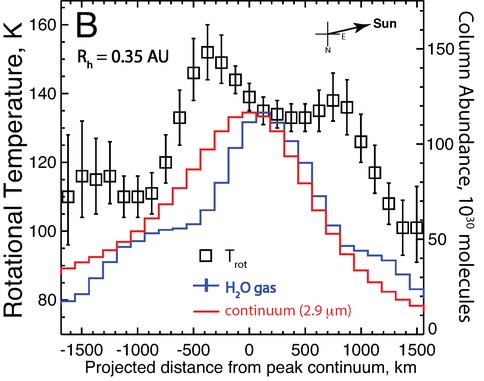2014 Annual Science Report
 NASA Goddard Space Flight Center
Reporting | SEP 2013 – DEC 2014
NASA Goddard Space Flight Center
Reporting | SEP 2013 – DEC 2014
Fundamental Properties Revealed by Parent Volatiles in Comets
Project Summary
We studied water and other prebiotic molecules in the atmospheres of comets C/2012 S1 (ISON) and C/2013 R1 (Lovejoy). These projects aim at improved understanding of cometary chemistry – a test bed for the contribution of comets to the delivery of exogenous prebiotic organics and water to early Earth, hypothesized as a precursor event to the emergence of the biosphere.
Project Progress
We uniquely probed the physical environment in the inner coma of comet C/2012 S1 (ISON) during its first (and last) approach to the Sun since being emplaced in the Oort Cloud some 4.5 billion years ago. We extracted H2O production rates and spatial profiles of gas rotational temperature and molecular column abundance (Figure 1), observed at heliocentric distances of 0.53 and 0.35 AU. Our observations revealed a comet evolving on various time-scales, both over hours and days. At 0.35 AU, ISON showed a considerable decrease in water production rate in less than 2 hr, likely declining after a major outburst.
The applied technique extends the state-of-the-art for spatial-spectral studies of coma physical parameters, revealed through long-slit studies of cometary water – the most abundant primary volatile in the coma. Our measured spatial distributions of temperature not only serve as a sensitive probe of the near-nucleus environment, but also are diagnostic for how water vapor is released in comets – directly from the nucleus versus via extended release from icy grains in the coma. These are fundamental questions in cometary science, relevant to understanding of both surface and interior evolution and critical for obtaining the most accurate abundances of water and prebiotic molecules.
Publications
-
Bonev, B. P., DiSanti, M. A., Villanueva, G. L., Gibb, E. L., Paganini, L., & Mumma, M. J. (2014). THE INNER COMA OF COMET C/2012 S1 (ISON) AT 0.53 AU AND 0.35 AU FROM THE SUN. The Astrophysical Journal, 796(1), L6. doi:10.1088/2041-8205/796/1/l6
-
PROJECT INVESTIGATORS:
-
PROJECT MEMBERS:
Boncho Bonev
Project Investigator
Michael DiSanti
Co-Investigator
Erika Gibb
Co-Investigator
Michael Mumma
Co-Investigator
Geronimo Villanueva
Co-Investigator
Karen Magee-Sauer
Collaborator
Lucas Paganini
Collaborator
-
RELATED OBJECTIVES:
Objective 2.2
Outer Solar System exploration
Objective 3.1
Sources of prebiotic materials and catalysts
Objective 4.3
Effects of extraterrestrial events upon the biosphere
